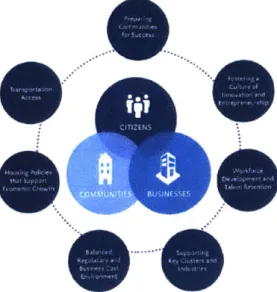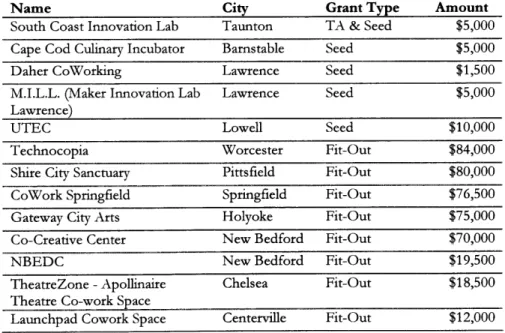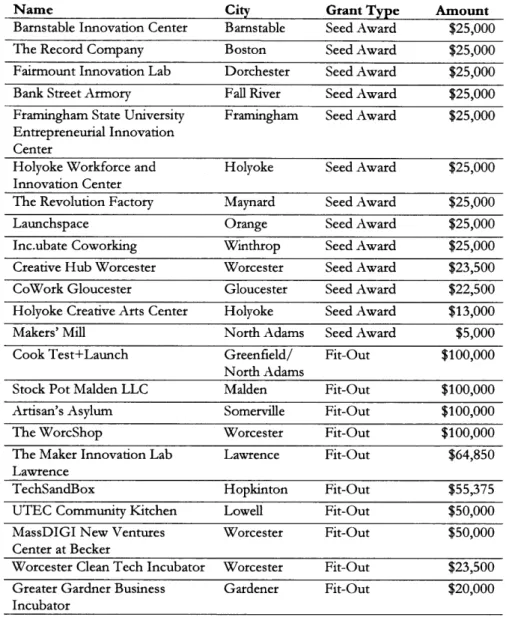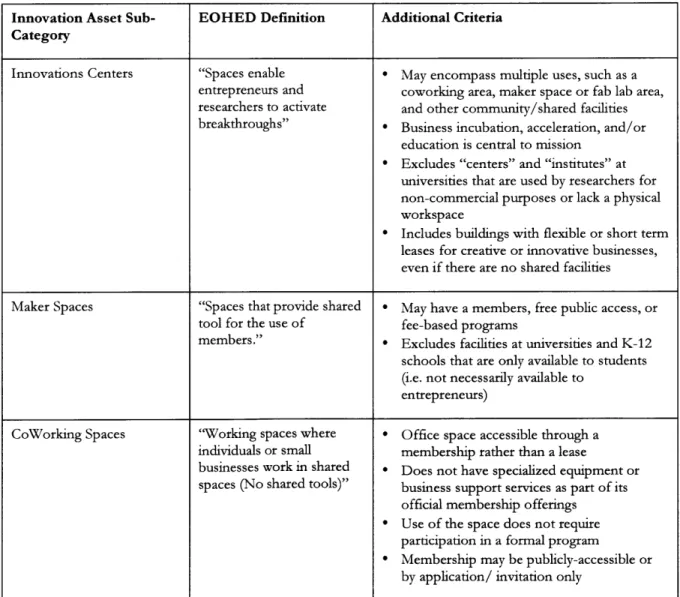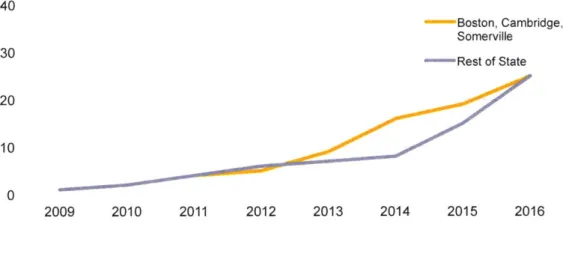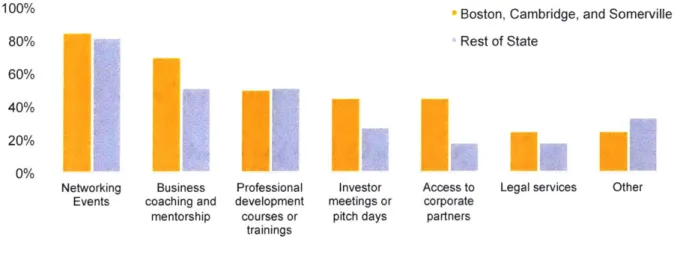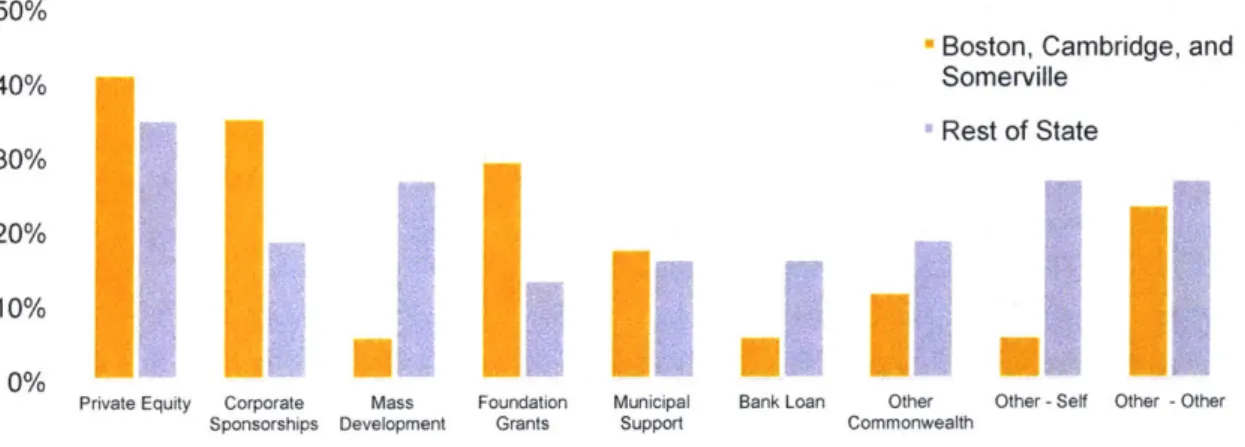Developing Common Wealth:
Workspaces for Innovation and
Entrepreneurship in Massachusetts
Rachel Belanger B.A. Environmental Studies
University of Chicago, 2011
Submitted to the Department of Urban Studies and Planning in Partial Fulfillment of the Requirements for the Degree of
Master in City Planning at the
Massachusetts Institute of Technology June 2017
2017 Rachel Belanger. All Rights Reserved
The author hereby grants to MIT permission to reproduce and to distribute publicly paper and electronic copies of this thesis document
in whole or in part in any medium now known or hereafter created.
Signature of Author: Certified by: -Accepted by: -MASSACHUSETTS INSTITUTE OF TECHNOLOGY
JUN 14 2017
Signature redacted
Department of Urban Studies and Planning May 22, 2017
Signature
redacted
Dr. Amy Glasmeier Professor of Economic Geography and Regional Planning Thesis Supervisor
Signature redacted
LU C
6
Associate Professor P. Christopher Zegras Chair, MCP Committee Department of Urban Studies and PlanningDeveloping Common Wealth:
Workspaces for Innovation and
Entrepreneurship in Massachusetts
Rachel Belanger
Submitted to the Department of Urban Studies and Planning
on May 22, 2017 in Partial Fulfillment of the Requirements for the Degree of Master in City Planning
Abstract
Over the last two decades, Boston and Cambridge have generated some of the strongest and most celebrated innovation districts - Kendall Square and the Seaport District - in which new models of commercial and civic real estate support dense webs of relationships among high-growth companies, academia, investors, mentors, and corporate R&D. Although beneficial for the overall competitiveness of the region, the wealth generated by these start-up and tech communities is not broadly shared, and the Commonwealth of Massachusetts's economic development policy, Opportunitiesfor All, has focused on reducing disparities across the state.
Meanwhile, the state's Gateway Cities present persistent challenges with lower than average incomes and weak market conditions for real estate development. Since 2014,
MassDevelopment's Transformative Development Initiative (TDI) has focused the state's investment in Gateway Cities on projects intended to generate follow-on private investment, including TDI Cowork grants for "collaborative workspaces," broadly defined. In an effort to
support communities of entrepreneurs across the state, TDI Cowork expanded into a state-wide Collaborative Workspaces Program in 2016.
Despite this interest in using community-oriented workspaces to catalyze new economic opportunities, policymakers, developers, and other economic development professionals in Massachusetts lack a comprehensive picture of what spaces are currently available that aim to
support innovation and entrepreneurship. A new inventory of workspaces utilized three categories from a previous list of innovation assets and found 50 "coworking spaces," 51
"innovation centers," and 20 "maker spaces." Of the 121 spaces, approximately 70 opened in the last three years and several others are expected to open in 2017. Survey data showed that spaces in Boston, Cambridge, and Somerville differ from those in the rest of the state in several ways
that are significant for stakeholders aiming to catalyze economic development, including a higher portion serving startup teams, providing access to corporate partners and investors, and
supporting members/users of digital products versus creative or professional services. Further analysis of the innovation ecosystem in Worcester suggested opportunities to attract mid-stage start-ups and mid-career entrepreneurs rather than focusing on undergraduate student retention as an economic development strategy.
Thesis Supervisor: Dr. Amy Glasmeier
Acknowledgements
Many thanks to my advisor, Dr. Amy Glasmeier, and reader, Dr. Elisabeth Reynolds, for sharing their wealth of expertise throughout this project;
To the dozens of leaders in Worcester, Boston, Cambridge, Somerville, and other cities and towns who shared their professional perspectives and personal stories and are a source of inspiration for this project and my career;
To my DUSP classmates, faculty and staff for creating a community that learns, organizes, and plays together;
To new and old friends - especially Becca, Elise, Sam, and Alex for the spontaneous dinners and talks; Kate, Lily, Hannah and Mira for adventures with food, nature, and infrastructure; Kate, Jacqui, and Steph for 22 years of listening; and Sarah for her spatial love;
To David, Debbi, and Dino, supporting me as family and as a friend; And to my parents for a lifetime of support in too many ways to count.
Table of Contents
Chapter 1. Introduction and Executive Summary... 7
Innovation Infrastructure: Trends Across Massachusetts ... 8
Innovation Ecosystems: The Boston Area and Worcester ... 9
Going Forward: Strategies for Worcester and Beyond ... 10
Chapter 2. Literature Review... 11
Innovation and Entrepreneurship as Economic Drivers ... 11
Defining Entrepreneurship: Small Business vs. Innovation Driven Companies...12
Urban Innovation Clusters and Ecosystems ... 12
The Role of Government in Supporting Innovation and Entrepreneurship ... 14
Public Policy Rationale for Subsidizing Incubators and Coworking Spaces ... 16
Chapter 3: Policy Context... 18
Past Studies of the Innovation Economy in Massachusetts...18
Recent Massachusetts Economic Development Policy ... 20
T D I C ow ork P rogram ... 21
Chapter 4: History of Spaces Supporting Innovation and Entrepreneurship...26
In cu b ato rs ... 2 6 A ccelerato rs...2 7 C o w o rkin g ... 2 8 M ak er Sp aces ... 29
Chapter 5: Analysis of Statewide Trends... 32
Inventory Methodology ... 32
Inv en tory F in dings...34
Survey M ethodology...39
Su rvey In sigh ts...39
Limitations of Survey Questions ... 42
Chapter 6. Innovation Ecosystems in M assachusetts... 44
In tro d u ctio n ... 44
The Boston, Cambridge and Somerville Ecosystem ... 44
Innovation and Entrepreneurship Spaces in Worcester ... 52
Chapter 7. Recommendations to Reinforce Worcester's Innovation Ecosystem.... 60
Reflections on Worcester's Innovation Infrastructure...60
A Framework for Local Strategy ... 62
Implications for Massachusetts Leadership ... 63
W orks Cited ... 64
Chapter 1. Introduction and Executive Summary
Over the last two decades, Boston and Cambridge have generated some of the strongest and most celebrated innovation districts - Kendall Square and the Seaport District - in which new models of commercial and civic real estate support a dense web of relationships among high-growth companies, academia, investors, mentors, and corporate R&D. The Cambridge Innovation Center alone houses over 1,000 start-ups and has recently expanded to Miami, St. Louis and Rotterdam. Economic activity in these districts has helped secure the region's
leadership in industries such as biotechnology, software, and computation and suggests that the most innovative activity of the 21st century will take place in walkable urban districts rather than suburban office parks.
Although beneficial for the overall competitiveness of the region, the wealth generated by Boston and Cambridge's start-up and tech communities is not broadly shared. In April 2017, the Boston metropolitan area ranked high on the "New Urban Crisis Index," a measure of wage and income inequality, economic segregation, housing unaffordability.1 This growth has also widened
the gap between economic opportunities in the Boston area and the rest of the state with the Baker-Politico administration's economic development plan, Opportunitiesfor
All
Making Massachusetts Great Everywhere, explicitly acknowledging that, "for some Massachusetts residents,the high-flying economy of Boston's Back Bay and Cambridge's Kendall Square can feel worlds away."2 Expanding opportunities outside the Boston area is also seen as a potential release valve on the city's tight housing market. As of April 2017, the median home price in Cambridge is $725,000, compared to $219,000 in Worcester and $256,000 in Lowell, and a wider gap than several years ago.3 Rents in Kendall Square have risen so quickly as to raise concerns about its ability to support the start-up activity that attracted larger corporation in the first place.4
The potential for the Gateway Cities to expand their share of the "innovation economy" is of particular interest because the Gateway Cities simultaneously present some of the most stubborn redevelopment challenges in the state and the most promising opportunities for urban districts outside the Boston area to support innovation and entrepreneurship. The Gateway Cities are a set of 26 cities, first identified in 2007 based on populations of at least 35,000, high poverty rates, low educational attainment levels, and strong manufacturing heritage.5 Building off numerous reports by the Massachusetts Institute for the New Commonwealth (MassINC), Massachusetts Legislature established the Transformative Development Fund in 2014, which guided MassDevelopment's investments in Gateway Cities into high-priority districts and established new resources for technical assistance, professional fellowships, and grant making. These programs, known as the Transformative Development Initiative (TDI), seek to overcome weak market conditions and generate follow-on private investment.6 Among other components, the "TDI Cowork" program was designed to "support the emergence and expansion of
collaborative workspaces to support entrepreneurship and innovative activities that support business development."7
1
Florida, "The Geography of the New Urban Crisis."2 "Opportunities for All: The Baker-Polito Strategy and Plan for Making Massachusetts Great Everywhere."
3 "Boston MA Home Prices & Home Values."
4 Ledford, "Start-Ups Fight for a Place in Boston's Biotech Hub."
s Muro et al., "Reconnecting Massachusetts Gateway Cities: Lessons Learned and an Agenda for Renewal."
6 "Transformative Development Initiative [TDI]."
Despite the interest in using community-oriented workspaces to catalyze new economic opportunities, policymakers, developers, and other economic development professionals in Massachusetts lack a comprehensive picture of what spaces are currently available that aim to support innovation and entrepreneurship outside of traditional commercial leases. This paper explores the growth of this "innovation infrastructure" at two scales. First, for Massachusetts as a whole, how many spaces exist today, when did they open, and is there a typical size? How are these spaces geographically distributed between Boston, Cambridge and Somerville, the Gateway Cities, and other cities and towns? How do spaces differ across the state, in the types of
businesses and industries they support, the services they provide, and the reasons members/users leave? Then, this paper addresses the challenges and opportunities for Worcester, by comparing local perspectives on the innovation ecosystem with expansion strategies of Boston-area organizations such as MassChallenge, CIC, and Greentown Labs. This paper does not seek to evaluate the effectiveness or efficiency of TDI Cowork as a funding program but provides historical context for its activities and presents new data that may guide future initiatives at the state and local levels.
An underlying theme to this research is the pace of change in where and how innovative work takes place. In less than 10 years, the concept of coworking - a shared office space accessed through a membership fee rather than a lease - has unleashed new ways of thinking about workspace, in which workers prioritize flexibility, social interaction, amenities, and community identity. The most prolific coworking brand, WeWork, has expanded from its original SoHo location opened in 2011 to 138 locations in 19 U.S. cities and 13 other countries.8 Meanwhile, business incubators and accelerators concepts from the mid-twentieth century have expanded to a broad diversity of innovation centers that support early-stage companies and enable thought leaders to convene around emerging opportunities and challenges. Maker spaces also signal a trend towards rapid prototyping and de-centralized physical production with low barriers to entry.
Innovation Infrastructure: Trends across Massachusetts
In Chapter 5, this paper quantifies and describes trends in Massachusetts for three types of workspaces: coworking, innovation centers, and maker spaces. An inventory of
"innovation assets" compiled by the Massachusetts Executive Office of Housing and
Economic Development in 2016 was expanded and refined to approximately 120 spaces across these three categories. "Innovation Centers" is the broadest category in which many spaces include open work areas and shared equipment comparable to many coworking or maker spaces. More than half these spaces shared additional information on their development process,
operations, and membership base through an online survey and interviews.
Prevalence and Growth
- 121 spaces are currently in operation: 50 Coworking spaces, 52 Innovation Centers, and 19 Maker Spaces.
- At least 13 more are in planning or development stages.
- Half of coworking spaces are located in Boston, Cambridge, and Somerville and approximately 30% are in Boston alone. Only 10% are in Gateway Cities. 8 As of December 2016. https://www.wework.com/locations
- For innovation centers, 35% are in Boston, Cambridge, and Somerville and 42% are in Gateway Cities.
- Half of maker spaces are in Gateway Cities.
- At the start of 2017, there was at least 2.1 million square feet of innovation center space, 600,000 square feet of coworking space, and 123,000 square feet of maker space.
- Coworking spaces exist as small as 500 square feet and innovation centers as small as 1,000 square feet, yet both also exist over 100,000 square feet. Innovation centers have a median size of 13,250 square feet versus 5,500 for coworking spaces.
Survey Insights
- Compared to spaces in the rest of the state, spaces in Boston, Cambridge and Somerville, report higher levels of services and programming, especially business
coaching/mentorship, investor meetings, and access to corporate partners.
- Spaces in the "coworking" category report providing programming and services at nearly the same levels as spaces in the "innovation centers" category.
- A higher portion of spaces in the Boston area target a specific industry, formally or informally.
- The majority of "innovation centers" serve workers in a specific industry, officially or unofficially.
- Over 80% of Boston-area spaces report serving start-up teams, versus fewer than 50% of spaces in the rest of the state.
- Across the state, 80% of coworking spaces report that self-employed individuals are one of their primary users.
- Users in the Boston area stay for less time and are more likely to leave for another city. - Less than half of spaces support themselves with member/user fees, and a smaller portion
are financially independent outside the Boston area.
- Outside the Boston area, more spaces own their buildings and those that rent typically pay under $20 per square foot.
Innovation Ecosystems: The Boston Area and Worcester
To begin exploring the implications of state-wide trends for the Gateway Cities, Chapter 6 presents a series of examples of spaces that aim to support innovation and entrepreneurship. Staff of MassChallenge in Boston, CIC in Cambridge, and Greentown Labs in Somerville provided insight on their organization's expansion strategies and approaches to conducting ecosystem assessments. Recurring themes include the importance of mentor networks and corporate partners, accessibility in an urban area, and programming that creates an innovative community not limited to the startups using their workspace. Interviews in Worcester then focused on understanding the diversity of spaces in that smaller innovation ecosystem: who are the users, what are the strengths of Worcester they leverage, and what linkages exist among institutions and workspaces.
The successes and challenges of expanding an innovation ecosystem in Worcester will guide its broader revitalization agenda and provide lessons for other Gateway Cities. Worcester has many of the ingredients needed for an innovation-based economy: nine colleges and
Boston. Downtown Worcester is ripe with signs of physical transformation, from new housing and retail, to refurbished office buildings, arts spaces and public realm infrastructure. This momentum is a promising trend but there is still a long way to go to secure Worcester's position as a regional anchor of innovative economic activity.
Going Forward: Strategies for Worcester and Beyond
Increasing innovation and entrepreneurship in Worcester will require involvement from all sectors and industries - a collaborative spirit that already exists among the city's leaders in government, other economic development organizations, academic leadership, and workspace operators. Drawing from the Worcester Regional Chamber of Commerce's framework of "Recruit, Retain, Incubate," I recommend a fourth strategic goal to Connect to the powerful innovation ecosystems in the Boston area. I also describe ways that strategies of "recruit," "retain," and "incubate" might better target companies and individuals at various life stages.
- Connect: Programming should actively direct young entrepreneurs towards the world-class resources that are a one-hour train or bus ride away in Boston, especially during early growth stages.
* Recruit: Incubators and collaborative workspaces in Worcester could more explicitly target mid-career entrepreneurs and mid-stage startups whose viability no longer depends on proximity to venture capital, mentors, and other resources.
- Retain: Although undergraduates are an important resource for the city, other groups of innovators and entrepreneurs such as faculty, graduate students, and mid-career
professionals should not be overlooked as valuable contributors to an innovation ecosystem.
* Incubate: The City of Worcester, Worcester Public Schools, the Commonwealth of Massachusetts, private landlords, and local universities and hospitals should all embrace opportunities to be a startup's first customer for hardware and software innovations. These recommendations are drawn from observations and analysis of Worcester and are not necessarily transferable to other Gateway Cities. However, future economic development in each of the Gateway Cities will surely require a multi-pronged approach that leverages regional assets while finding opportunities for differentiation. This analysis of innovation infrastructure across the state and the description of innovation ecosystems in this report aim to advance discussion on the changing nature of economic opportunity across Massachusetts.
Chapter 2. Literature Review
Innovation and Entrepreneurship as Economic Drivers
Most literature on innovation and entrepreneurship starts from the belief that they are the source of economic growth. This common assumption stems from Joseph Schumpeter's
concept of "creative destruction" coined in 1942, which asserted capitalism leads to constant changes in the structure of the economy.9 This idea has resonated through the technological changes of different eras, in which one invention is superseded by another and production processes are reconfigured in ways that lose and create jobs.
In an increasingly globalized economy, "creative destruction" still describes the dynamics of job turnover that are not fully captured by employment and job creation statistics. For
example, the Federal Reserve Bank of Dallas invoked the idea of "creative destruction" in a 1992 essay describing the emergence of high tech industries in the 1980's and early 90's when major companies cut thousands of jobs each. According to the essay, "[i]t is this churning of business enterprises and their workforces in a free enterprise economy that spurs income growth and creates wealth."o However, the optimism that innovation would fuel prosperity on a national or regional scale was accompanied by concern about its uneven distribution and those who get left behind. New jobs are often not replacements for old ones in terms of the training required and may be in different locations.
National policy and much economic development literature still remain strongly influenced by faith in innovation and entrepreneurship. In a 2004 report from the U.S.
Economic Development Administration, Assistant Secretary for Economic Development David Sampson wrote:
"The focus of economic development should be on supporting innovation, increasing prosperity for American businesses and ensuring American workers have the skills to remain the most productive workforce in the world. Innovation will drive the growth of American industry by fostering new ideas, technologies and processes that lead to better jobs and higher wages - and as a result, a higher standard of living." 11
This belief was reinforced by the Kauffman Foundation's finding that in 2007, firms in existence for less than five years accounted for two thirds of job creation despite the majority of jobs remaining in older firms. This research indicated entrepreneurship would be a key to post-recession economic recovery.12 "Innovation" was the eighth most common keyword in Economic
Development Quarterly articles from 2003-2011, associated with seven percent of all articles.13
Additionally, entrepreneurship is seen as a promising response the loss of manufacturing jobs when "small businesses may be an even more critical pathway than ever to mobility and opportunity - not just for the business owner, but also for those who fill the jobs that business creates."14
9 Schumpeter, Capitalism, Socialism and Democracy.
10 "The Churn."
11 Paytas, Gradeck, and Andrews, "Universities and the Development of Industry Clusters." 12 Stangler and Litan, "Where Will the Jobs Come From?," 6.
13 Currid-Halkett and Stolarick, "The Great Divide," 150.
Defining Entrepreneurship: Small Business vs. Innovation Driven Companies
In order to further study the role of entrepreneurship in economic growth, it is important to define what types of business activities are meant by "entrepreneurship." In research
sponsored by the Kauffman Foundation, Aulet and Murray (2013) distinguish between "Innovation Driven Enterprises" and "Small and Medium Enterprises." They explain
fundamental differences between new companies that intend to grow - either by creating a new technology or applying technology in a new ways - and those that will remain small because of the nature of their business - typically service-based with the intention of serving a local customer base. 15
This same distinction is used in a February 2016 report from the MIT Innovation Institute, which shows only a small portion of new businesses experience the dramatic growth
that drives the economy. Research on entrepreneurship has "by and large abstracted away from firms' initial differences in growth potential-tracking the rate of entrepreneurship by either counting new
firms...
or selecting on achieving a performance outcome (such as the receipt of venture funding)."16 When controlling for firm age, it becomes apparent that young companies(start-ups) are responsible for the job creation benefits often associated with small business.17 Additionally, IDEs have a job multiplier effect, creating five jobs for every direct IDE job.18 However, SME can still be valuable to economic development given that "self-employment and
SME creation are critical to moving people out of unemployment, particularly during periods of austerity."1 9
Urban Innovation Clusters and Ecosystems
Countless studies of innovation have noted its uneven geographic distribution and tendency to concentrate in cities, yet the implications of clustering and innovation ecosystems remain unclear for smaller cities. For example, Maryann Feldman's 2002 book Institutions and
Systems in the Geography ofInnovation started from the assumption that innovation impacts an
economy's rate of growth, but that there is "a limited understanding of the sources of technical progress and the reasons that innovation varies across time and space."20 Meanwhile, studies of global cities reinforce the idea that digital technology, rather than leveling the playing field for innovators in diverse locations, creates a newfound importance on being in centralized
locations.21 "Telecommuting" and other opportunities to work remotely did not reduce the value of collaborating and interacting in physical spaces, and cities are thus valuable information centers in a globalized economy.22
While high-paying jobs continue to concentrate in global cities, the concept of industry clusters provides some hope for smaller cities to stake out a new competitive advantage in the 21st century. The term concept of clusters emerged with Michael Porter's influential 1998 paper on how global markets and new communications technology had not erased the phenomenon of 15 Aulet and Murray, "A Tale of Two Entrepreneurs."
16 Fazio et al., "A New View of the Skew: A Quantitative Assessment of the Quality of American
Entrepreneurship," 1.
17 Haltiwanger, Jarmin, and Miranda, "Who Creates Jobs?" 18 Moretti, The New Geography ofJobs.
19 Aulet and Murray, "A Tale of Two Entrepreneurs."
20 Feldman, Institutions and Systems in the Geography of Innovation. 21 Sassen, "The Global City."
cities having an exceptional concentration of jobs within a particular industry. According to Porter, clusters function,
"first, by increasing the productivity of companies based in the area; second, by driving the direction and
pace of innovation, which underpins future productivity growth; and third, by stimulating the formation of new businesses, which expands and strengthens the cluster itself."23
At the time, Porter recognized Boston as a cluster of mutual funds, biotechnology, software and networking, and venture capital, with Western Massachusetts home to a separate cluster in the polymers industry. However, identifying regional clusters does little to explain to what extent cluster formation is an organic process, or to what extent it can be planned and directed.
In the Boston region, the distribution of technology jobs in the last 30 years illustrates a broader trend in innovation activities returning to urban cores after decades of suburban growth. The Route 128 corridor and later 1-495 are famous for the explosion of high-tech jobs in the 1980's, with technology commercialization linked to MIT but new office developments located in quiet suburban areas. Annalee Saxenian's 1996 RegionalAdantge, which explained structural differences between Route 128 and Silicon Valley's entrepreneurial communities, has been cited over 11,000 times, cementing Route 128's role in the geographic history of innovation. Across the country, two-thirds of office facilities were located in "edge cities" by the early 1990s, and the vast majority of these had appeared in less than two decades.24
Today, the Route 128 corridor is still home to a significant number of jobs, but venture capital, startup offices, and accelerator programs are largely oriented towards the city. The Kendall Square area adjacent to MIT is recognized as the epicenter of the Boston region's biotech community, in addition to being home to offices of Google, Microsoft, Amazon, Facebook, and other tech corporations. The re-urbanization of start-up activity can be attributed to both changing preferences - such as living and working in walkable neighborhoods - and practical benefits of working in close proximity to other entrepreneurs, investors, and researchers. Recent research suggests that the "the suburban model might have been an
historical aberration, and that innovation, creativity, and entrepreneurship are realigning in the same urban centers that traditionally fostered them."25
The phrase "innovation ecosystem" emerged in the last 20-25 years to underscore the value of relationships and information flows among innovative enterprises. Borrowing from
ecological science, "an innovation ecosystem models the economic rather than the energy dynamics of the complex relationships that are formed between actors or entities whose functional goal is to enable technology development and innovation."26 Some uses of "innovation
ecosystem" describe factors impacting a specific product without focusing on a particular place27 while others focus on national- and international-scale systems.28
However, the "ecosystem" metaphor can also be used to describe the sense of community and relationships within a city or
district: which organizations work together? How to innovators move from one company to another and learn together? From its analysis of the Kansas City startup community, the Kauffman Foundation found that "even in this digital age and with costless, powerful
23 Porter, "Clusters and the New Economics of Competition," 80.
24 Garreau, Edge Cify, 4-5.
25 Florida and Mellander, "Rise of the Startup City."
26
jackson, "What Is an Innovation Ecosystem."
27 Adner and Kapoor, "Value Creation in Innovation Ecosystems."
28
communication tools such as Twitter, entrepreneurship is largely a local phenomenon using personal connections, and entrepreneurs primarily exchange information via word of mouth."29
Universities play a prominent role in literature on both clustering and innovation
ecosystems, and their potential impact is important to understand for this thesis because they are an existing resource in many Massachusetts cities. With multiple roles in basic research,
technology creation, and workforce development, "the university is the creative side of economic destruction"30 and "universities can also be important anchor tenants for regional clusters."31 This role has evolved with public policy, as the federal Economic Development Administration described:
"Technology transfer became more formalized as a university function in the late 1970s, and is
becoming increasingly important at universities across the country, as a source of revenue, a stimulus to the regional economy, and a method of bringing research into practical use."32
The concept of "spin-off" companies is related but distinct from technology transfer because it implies academics acting as entrepreneurs in addition to contributing inventions to a business community. "Anecdotal evidence suggests an important role for universities in generating clusters of innovative 'spin-off' companies, although econometric evidence on the presence of localized knowledge spillovers from universities is mixed."33 Physical space to support
entrepreneurs on and off-campus is also important, since "university-based entrepreneurship ecosystems" often include incubators in addition to other efforts to provide access to university resources and coordinate research initiatives.34
The Role of Government in Supporting Innovation and Entrepreneurship
In the U.S., policy aimed at supporting entrepreneurship dates back to the founding of the Small Business Administration in 1953.35 Following World War II, increased demands for national defense strengthened the relationship between government, private innovation, and academic research. Throughout the Cold War, the federal government played a key role in "the growth of new industries and regions by channeling resources to university labs to develop war-related technologies."36 Then, in the 70's and 80's, many states' cooperative technology initiatives marked a "new breed of state policies," that fostered the development of resources within the
state instead of working to attract existing industries to locate in their states.37 Technology initiatives also shifted from an emphasis on pure research that utilized university partnerships "in hopes of creating new knowledge that would then drive applied research and eventually
commercialized products," to a new focus on applied research when early initiatives did not produce clear financial returns.38
Government programs aiming to support innovation and entrepreneurship have addressed the themes described above of clusters, innovation ecosystems, and university spin-offs. From
29 Motoyama et al., "Think Locally, Act Locally."
30 Paytas, Gradeck, and Andrews, "Universities and the Development of Industry Clusters," 14. 31 Chatterji, Glaeser, and Kerr, "Clusters of Entrepreneurship and Innovation."
32 Paytas, Gradeck, and Andrews, "Universities and the Development of Industry Clusters."
33 Agrawal and Cockburn, "University Research, Industrial R&D, and the Anchor Tenant Hypothesis."
34 Fetters et al., The Development of University-Based Entrepreneurship Ecoystems. 3 Chatterji, Glaeser, and Kerr, "Clusters of Entrepreneurship and Innovation," 19.
36 Saxenian, RegionalAdvantage, 11.
37 Riggle and Stough, "Evaluating State Cooperative Technology Programs," 642.
2009-2015, federal government programs funded 56 cluster initiatives for industries such as green energy and defense contracting.39 However, "while arguments exist for and against policy
support of entrepreneurial clusters, our understanding of what works and how it works is quite
limited."40
Although there are many possible programs to support entrepreneurs, "supporting a cluster of small-scale entrepreneurs allows policy makers to affect many entrepreneurssimultaneously, providing important scale to their policy interventions."41
Inspired by research on the economic benefits of industry clusters, it is thought that, ''governments can help create innovation ecosystems that build on a given region's
entrepreneurial strengths."42 Growing or strengthening an innovation ecosystem can mean fostering partnerships: "Business, government, research universities and community colleges all need to be involved, as well as the entrepreneurs themselves."43 Another approach to supporting innovation ecosystems - strategically attracting anchor firms/tenants - may have less direct
benefits for new companies but help to link innovation policy with older economic development strategies. Thus in negotiations to recruit large firms, "local governments need to know how much a large firm is worth to the local economy; thinking about the role of anchor tenants in mediating spillovers and shaping natural advantage may provide a useful framework for analysis."44
A common problem in innovation policy is to try to replicate the regions seen as the most innovative and entrepreneurial. As Feldman et. al (2005) say of efforts to mimic Silicon Valley,
"Looking at a successful region in its full maturity, however, may not provide prescriptive information about how such regions actually develop."45 The authors describe how in the Washington, D.C. region, the formation of a cluster is best traced to the efforts of individual
entrepreneurs, rather than public policy or university relationships, illustrating that clusters can form through different trajectories.
Another common criticism of government innovation programs is that they have to pick winners and losers - either inequitably prioritizing some types of companies, or spreading
resources thinly and without a clear strategy. One concern is that "when governments intervene to encourage the creation of new businesses, they stimulate more people to start new companies disproportionately in competitive industries with lower barriers to entry and high rates of failure."46 Another problem is in how programs measure success:
"policies that aim to increase 'shots on goal' and implicitly treat all firms as equally likely candidates for growth are likely to expect 'too much' from the vast majority of new businesses, by focusing on a lever-new firm formation-that is only weakly related to economic growth."47
This issue is seen in programs that address "start-ups" and "small business" without
distinguishing between the needs of companies with different growth trajectories. Around the world, "Various organizations' enthusiastic efforts to support entrepreneurship fail to achieve the results they desire, precisely because they try to address SME and IDE entrepreneurship
39 Mills, "A Playbook for Making America More Entrepreneurial."
40 Chatterji, Glaeser, and Kerr, "Clusters of Entrepreneurship and Innovation."
41 Ibid., 3.
42 Mills, "A Playbook for Making America More Entrepreneurial." 43 Ibid.
44 Agrawal and Cockburn, "University Research, Industrial R&D, and the Anchor Tenant Hypothesis." 4 Feldman, Francis, and Bercovitz, "Creating a Cluster While Building a Firm," 137.
46 Shane, "Why Encouraging More People to Become Entrepreneurs Is Bad Public Policy," 146. 47 Fazio et al., "A New View of the Skew: A Quantitative Assessment of the Quality of American Entrepreneurship."
through a singular organization."48 Supporting SME's seems to produce more immediate, visible results, yet when job creation data is studied at a more granular level, it is seen that net job creation is driven by IDE's. This suggests that, "If job creation and economic prosperity are the goals for a government, IDE entrepreneurship must be a major element of government strategy and policymaking."9 One response is that policy makers "need to think like venture capitalists and concentrate time and money on extraordinary entrepreneurs, and worry less about the typical ones."50
Public Policy Rationale for Subsidizing Incubators and Coworking Spaces
Debate about whether government should support business incubators stems from questions of how and to what extent incubators actually enhance entrepreneurship and economic development. In large-scale studies of business incubators around the world, three "generations" of business incubators are seen with progressively rich and targeted service offerings. The first generation focused on the provision of physical space and shared resources (generating economies of scale). The second generation offered business support when "It became clear that innovation and technology were becoming the cornerstones of economic growth and that new strategies were necessary to revitalize economies."5 1
The metrics used by business incubators to illustrate impact - graduation rates, long-term success rates, and job created - can be compelling but overlook the need for a control group: how would these businesses have fared in the absence of the incubator. For example, lower business failure rates associated with incubators could simply be due to their members being savvy entrepreneurs who seek out the lowest-rent space available. 52 Recent criticisms and concerns include economist Scott Shane's reaction to a 2012 proposal for the Business Incubator Promotion Act "Before Congress spends money on business incubators, it should first ask for convincing evidence that a market failure exist - that the private sector fails to provide incubation services - and for evidence that incubators cause companies to create jobs."
However, studies of business incubator impact dating the mid-1980s and focus on the value of both physical space and the services, programming, and networking opportunities, where "Effective incubator organizations socialize would-be entrepreneurs to values, aspirations, and technical skills."53 Mian's 1996 study of "university technology business incubators" was the first to look systematically at their impact on "new technology-based firms" and found that companies benefitted from "university-related inputs such as university image, laboratories and equipment, and student employees."s4
These studies of impact came about because providing incubator space for startups was "latest fad in economic development"55 and seen as a central part of a "home-grown economic development" strategy. 56 In the mid-1980s, key characteristics of publicly supported small
48 Aulet and Murray, "A Tale of Two Entrepreneurs." 49 Ibid.
50 Shane, "Why Encouraging More People to Become Entrepreneurs Is Bad Public Policy," 146.
51 Bruneel et al., "The Evolution of Business Incubators."
52 Shane, "Why Congress Shouldn't Fund Business Incubators (Opinion)."
o
Miller and C6ul, Growing the next Silicon Valley, 63.54 Mian, "Assessing Value-Added Contributions of University Technology Business Incubators to Tenant Firms."
ss Miller and C6t6, Growing the next Silicon Valley, 123.
business incubators that distinguished them from other office buildings and research parks were below-market rents, business development services, and entry/exit policies and procedures. Incubators were promoted by both state and local governments and faced several public policy issues: criticisms of creating unfair competition, the risk proposition of catering to short-term tenants, restricted versus open admissions policies, and unclear expectations about access to capital. Despite these policy issues it was accepted that incubators would be valuable public private partnerships that "link a community's assets and resources with the entrepreneurial culture."157
In the current climate of intense competition between start-ups, there is a renewed enthusiasm and optimism for coworking and incubators to create economic opportunity and jumpstart entrepreneurial communities. A 2016 Atlantic article claimed that incubators and accelerators "helped rebuild a city" in Post-Katrina New Orleans and that they are "increasingly recognized across the country as amplifiers of small-scale entrepreneurship and innovation."58
57 plosila and Allen, "Small Business Incubators and Public Policy."
Chapter 3: Policy Context
Past Studies of the Innovation Economy in Massachusetts
The Massachusetts Technology Collaborative has played a central role in tracking the evolution and performance of the state's innovation economy in an annual index since 1997. By defining which sectors to analyze as part of the "innovation economy," the indices have shown "the connection between research, development, technology, commercialization, and new industry growth." In an era when economic policy and analysis typically focused on single industries, the Indices reframed public discussions to address a "system of innovation" more holistically.59 They have also influenced the ways that theories of innovation economies are applied to state policy; the introduction to the 2001 Index says directly that this analysis "based upon the premise that innovation is a critical factor in the growth of the state's economy."0
The "2015/2016 Index of the Massachusetts Innovation Economy," emphasized the economic impact of the state's innovation economy, including the fact that job growth exceeded growth in the rest of the economy and wages are much higher. The annual index compares Massachusetts to other "Leading Technology States," on numerous indicators and the 2015/2016 Index ranked Massachusetts above the other "Leading Technology States" on metrics such as innovation economy employment concentration, total innovation economy employment, and the number of key sectors in which it has an above average employment concentration.6 1
While recent Indices have been optimistic and celebratory, several years point to the fact that Massachusetts's current leadership in some industries was never guaranteed. For example, the 2004 Index was introduced with "a note of urgency because employment in the state's Innovation Economy continues to shrink, led by losses in Information Technology-related industries." At that time, the state's largest industry clusters - Software & Communications Services and Computer & Communications Hardware - were impacted the most, while the life sciences sector appeared to gather strength and put Massachusetts "in a position to be a global leader in the life sciences." The 2005 Index then held a cautiously optimistic tone while noting that "seven of nine Massachusetts Innovation Economy clusters continued to shed jobs in 2004, and at a rate faster than competitor Leading Technology States."
Although the annual indices focus on indicators across the state as a whole, 2001 and 2014 both explored regional strengths and disparities within the state as part of a "Special Analysis" section. According to the 2001 Index, booms in the 1980's and 90's saw the expansion of technology industries outside of Boston and past 1-495. Yet, the 2001 index anticipates growing disparities:
"the growth of the Innovation Economy in each region of the state hinges heavily on the ability of each region to upgrade the educational levels and skills of current residents, and the attraction of the region to out- siders who will bring new technical and entrepreneurial skills into a region's industries." This analysis follows a similar format as the comparison of Massachusetts to other Leading Technology states; it focused on key metrics such as cluster employment and unemployment rates but does not delve into the specific assets and opportunities within each region. The 2014 Index was the next to compare regions within Massachusetts, again noting "the strengths that s9 "10 Years of the Index of the Massachusetts Innovation Economy."
60 "Index of the Massachusetts Innovation Economy 2001."
make greater Boston an important node in the global economy are leveraged by the rest of Massachusetts along with regional strengths to drive cluster growth." This analysis almost entirely focuses on legacy industries and the future of the paper industry in Central and Western Massachusetts as a promising transition to new production technologies and markets. However, in both these 2001 and 2014 analyses, the role of cities is overshadowed by an emphasis on regions, and it is not clear how urban centers outside the Boston area might contribute to the innovation economy.
The discussion of physical space for innovation has played a limited role in the annual Indices of the Innovation Economy. The annual indices for 2005-2008 used "Business
incubators per 10,000 business establishments" as a key indicator, with Massachusetts ranked in the top two Leading Technology States with Virginia. The 2008, 2009, 2010 and 2011 indices define "innovation infrastructure" and mentioned, but did not measure, "physical spaces in which innovators work and interact, such as laboratories, incubators, and venues which allow innovators from across the economy to come together." Then in 2012, it notes that, "The past
few years have witnessed the emergence of new networks, incubators, accelerators, and
competitions - either stand-alone efforts or new offerings from existing industry and technology organizations." Then the 2013 and 2014 indices make no mention of incubators or innovation infrastructure except for an analysis of broadband in the more traditional sense of infrastructure.
The 2015/2016 Special Analysis focused on collaborative workspaces, which were further categorized into co-working, maker spaces, incubators and accelerators. This analysis presents a logic that echoes other studies on entrepreneurship: first, that new companies are responsible for net job growth; second, that start-ups face challenges becoming sustainable businesses; and third, that these challenges encompass access to physical space as well as business acumen. As a result, "Collaborative workspaces can be one way to support the pipeline of new firms in a regional economy." Among the key findings of this study is that "[s]paces outside of Greater Boston face greater challenges in attracting funding and a critical mass of start-ups but nevertheless there is
significant demand for collaborative workspaces outside of Greater Boston." This study counts 33 coworking spaces, 25 maker spaces, 26 incubators, and 15 accelerators. Among these, North Shore Innoventures, the UMass Lowell Innovation Hub, and Greentown Labs in Somerville are featured as case studies.
The 2015/2016 Special Analysis on collaborative workspaces utilized an "Innovation Asset Mapping" inventory led by the Commonwealth's Executive Office of Housing and Economic Development, most recently updated in February 2017. The Innovation Asset
Mapping, developed to support in executing the OpportunitiesforAll plan listed spaces,
organization, programs and connections across the state - a total of 758 assets - and provided a count by region and municipality. Among the spaces, the inventory uses five categories:
Innovation Centers, Maker Spaces, Artist Spaces, Collaborative Kitchens, and Coworking Spaces. About one-third of the assets listed were spaces (229), of which there were 51 coworking spaces, 35 innovation centers, and 34 maker spaces using the following definitions:
- "Innovation Centers: Spaces enable entrepreneurs and researchers to activate breakthroughs
* Maker Spaces: Spaces that provide shared tool for the use of members.
- CoWorking Spaces: Working spaces where individuals or small businesses work in shared spaces. (No shared tools)"
These broad categorizations suggest an opportunity to further define each type of space and how they function to support innovation and entrepreneurship. In addition, the list of assets suggests
that it may not be capturing a comprehensive count of assets, since it groups chains such as WeWork and Workbar into a single line.
Recent Massachusetts Economic Development Policy
Over the last decade, efforts to support innovation in Massachusetts have often focused on specific industries. For example, under Deval Patrick, the 2008 Life Sciences Act committed $1 billion over 10 years to secondary education, workforce development, academic research and commercialization, and businesses. The Act established the Massachusetts Life Sciences Center in Waltham, to implement the $1 billion investment. With the goal of supporting growth across the state, the act allocated funds towards spaces to support new businesses including some of the following in Gateway Cities: a life science incubator building at the William Stanley Business Park in Pittsfield, a new nano and biomanufacturing facility at the University of Massachusetts at Lowell, a life sciences incubator in Springfield, and a regional incubation center for life science initiatives in New Bedford.62 Through this 2008 act, it is evident that Massachusetts' global leadership in the life sciences industry today cannot be solely attributed to organic growth and the presence of top research universities.
The policy focus on geographically distributed innovation and entrepreneurship continued to grow throughout the Deval Patrick administration (2007-2015). The 2014 "Act Promoting Economic Growth across the Commonwealth" committed a total of $80 million including $16 million to the Transformative Development Fund, of which up to $2 million could be used to promote collaborative workspaces. Per the 2014 Act, collaborative workspaces would "foster collaboration and linkages among innovative and creative enterprises by providing central locations for such businesses or individuals to work in an environment designed to promote sharing of resources, experience and expertise." MassDevelopment, in administering the funds, should give preference to proposals with the following criteria: "redevelop at least 10,000 square feet in existing properties located in the downtown area of a gateway municipality; dedicate at least 25 per cent of accessible space to collaborative use; and support a cluster of at least 15 separate occupants." The 2014 Act also included funds to establish business incubators in Northborough and Lancaster, support for the Massachusetts Medical Device Development Center at UMass Lowell, and $2 million for the Massachusetts Technology Collaborative to "create a talent pipeline to technology startups and innovation companies."63
The Baker-Polito administration's economic development plan, OpportunitiesforAll Making
Massachusetts Great Everywhere, builds thematically on the Patrick administration's 2014 legislation
by emphasizing workforce development and the potential for innovation to reach all regions of the Commonwealth. The second policy priority, "Fostering a Culture of Innovation and Entrepreneurship," claims that "small businesses and startups remain the backbone of the Massachusetts economy" and "business formation drives a state's overall economic health."64 Among five strategic goals for that policy priority is to "support and improve the state's
innovation infrastructure," including co-working spaces, venture centers, maker and artist spaces, incubators and accelerators, classes, competitions, meet-ups and interactions with thought leaders.
62General Court of the Commonwealth of Massachusetts, An Act Providing for the Investment in and Expansion of the Life Sciences Industry in the Commonwealth.
63 An Act Promoting Economic Growth Across the Commonwealth.
Figure 2.1. Policy Priority Areas in Oppertxxities for All (2015)
Building off the Transformative Development Initiative fund, which is administered by MassDevelopment, the Commonwealth passed An Act Relative to Job Creation and Workforce
Development in August 2016. This economic legislation renewed the Transformative Development
Initiative and added a Community Innovation Infrastructure Fund that supports co-working spaces, venture centers, maker spaces and artist spaces. In addition, an Angel Investor Tax Credit "promotes startup activity and job creation in the Gateway Cities, by incentivizing investment in early-stage life sciences and digital health firms." Upon signing this legislation, Governor Charlie Baker noted, "this legislation unleashes valuable opportunities for investments in the development of revolutionary new technologies and community-based innovation,
connecting every region of the Commonwealth to the innovation economy."65
TDI Cowork Program Grant Recipients: 2014-2016
Transformative Development Funds administered by MassDevelopment for collaborative workspaces, per Chapter 287 of the Acts of 2014, are documented in a series of annual reports. In the program's first four months - August to December 2014 - MassDevelopment awarded $172,800 in grants, reviewed $510,000 in projects, and built a pipeline of 10-12 additional projects. The grants were categorized as early-stage Seed Grants or larger Fit-Out Grants and were awarded via a rolling Request for Proposals process. Five of the six grants were seed grants of $5,000 or less, and a single fit-out grant of $150,000 was awarded.66 The individual grants and their amounts are listed below in Figure 2.2.
In 2015, grants were still made in "seed" and "fit out" categories, but this time nearly all the funds - $640,000 out of $645,000 - were for fit out grants. These four fit-out grants ranged
65 "Governor Baker Signs Economic Development Legislation." 66 "Transformative Development Initiative Annual Report 2014."
from $80,000 to $250,000, and the 2014 and 2015 grants accounted for nearly 50,000 square feet of space in eight Gateway Cities. The following criteria, defined in the Request for Proposals, broadly address the siting within Gateway Cities, physical characteristics of the space, and long-term operations and programming:
- "Locate in a central, visible area supported by other active uses/amenities that support the growth of the community of users;
- Demonstrate a real community of existing and potential users that their space operations planning (and equipment) would serve;
- Provide sufficient collaborative working areas and programming to promote interaction among members;
* Through design of the space and operations, have the potential to
o
foster the growth of the emerging innovation and creative economy in the Gateway Citieso
enhance the stability/foundation of a growing community of entrepreneurs and enterpriseso
spur new enterprises;- Help facilitate the rehabilitation of an underused building in a Gateway City; and Provide well-developed plans and organizational track record to operate the space, and grow the target community of distinctive identity and activities." 67
Most of these criteria speak to the intent and aspirations of the space subjectively, rather than quantitative criteria for spaces of a certain size or membership level. The criteria also leave open for interpretation how impact will be measured over time.
In FY16 - up to June 30, 2016 - MassDevelopment approved an additional five Seed Grants and eight Fit-Out'grants totaling $462,000. Although the total grant amount was less than the previous year, more organizations received grants, and the decline in grant size is seen in the median of $72,500 for fit-out grants. The FY16 report includes a summary of observations regarding grantee progress, program administration, and additional needs of coworking spaces. Among these observations were two related points that "Some spaces should focus more on a niche offering or strength as opposed to trying to be all things to all people" and "Some spaces will require a more defined focus to attract the right community of users and to ensure that the use of the space maximizes return to ensure sustainability."68
At the end of the 2016 TDI Cowork Annual Report, it was noted that MassDevelopment and EOHED would administer a combined "Collaborative Workspace Program" going forward, which would expand beyond the Gateway Cities. The first round of grants from this newest program was announced in December 2016 and comprised $952,000 for 23 grants, 11 of which were in Gateway Cities.69 Compared to the three years of the TDI Cowork pilot, the seed grants were significantly larger, with 11 of the 13 seed grants between $22,000 and $25,000 whereas most had been $5,000 in the past. The maximum fit out grants were $100,000, with a median of $60,000.
67 "Transformative Development Initiative [TDI] Cowork - Annual Report FY15."
68
"Transformative Development Initiative [TDI] Cowork Annual Report FY16."
Figure 2.2. TDI Cowork 2014 Recipients70
Name
EforAll Lawrence
Springfield Innovation Caf6 Quincy Innovation Center Gateway City Arts Co Work Springfield
Groundwork Coworking Space
City Lawrence Springfield Quincy Holyoke Springfield New Bedford Grant Type Seed Seed Seed Seed Feasibility Seed Feasibility Fit-Out
Figure 2.3. TDI Cowork 2015 Recipients7 1
Name
Shire City Sanctuary Shire City Sanctuary Lowell Makes New Vestures Theater Zone
South Coast Innovators Lab
City Pittsfield Pittsfield Lowell Lowell Chelsea Taunton Grant Type Seed Fit-Out Fit-Out Fit-Out Fit-Out Fit-Out Amount $5,000 $80,000 $160,000 $150,000 $250,000 in kind
Figure 2.4. TDI Cowork 2016 Recipients 72
Name City Grant Type Amount
South Coast Innovation Lab Taunton TA & Seed $5,000 Cape Cod Culinary Incubator Barnstable Seed $5,000
Daher CoWorking Lawrence Seed $1,500
M.I.L.L. (Maker Innovation Lab Lawrence Seed $5,000
Lawrence)
UTEC
Technocopia Shire City Sanctuary
CoWork Springfield Gateway City Arts Co-Creative Center
NBEDC
TheatreZone -Apollinaire Theatre Co-work Space Launchpad Cowork Space
Lowell Worcester Pittsfield Springfield Holyoke New Bedford New Bedford Chelsea Seed Fit-Out Fit-Out Fit-Out Fit-Out Fit-Out Fit-Out Fit-Out $10,000 $84,000 $80,000 $76,500 $75,000 $70,000 $19,500 $18,500 Centerville Fit-Out $12,000
70 "Transformative Development Initiative Annual Report 2014."
71 "Transformative Development Initiative [TDI] Cowork - Annual Report FY15."
72
"Transformative Development Initiative [TDI] Cowork Annual Report FY16."
Amount $4,000 $5,000 $5,000 $5,000 $3,800 $150,000
Figure 2.5. 2016 Collaborative Workspace Program Awards73 Name
Barnstable Innovation Center The Record Company Fairmount Innovation Lab Bank Street Armory
Framingham State University Entrepreneurial Innovation Center City Barnstable Boston Dorchester Fall River Framingham Grant Type Seed Award Seed Award Seed Award Seed Award Seed Award Amount $25,000 $25,000 $25,000 $25,000 $25,000
Holyoke Workforce and Holyoke Seed Award $25,000 Innovation Center
The Revolution Factory Maynard Seed Award $25,000
Launchspace Orange Seed Award $25,000
Inc.ubate Coworking Winthrop Seed Award $25,000 Creative Hub Worcester Worcester Seed Award $23,500 CoWork Gloucester Gloucester Seed Award $22,500 Holyoke Creative Arts Center Holyoke Seed Award $13,000
Makers' Mill North Adams Seed Award $5,000
Cook Test+Launch Greenfield/ Fit-Out $100,000
North Adams
Stock Pot Malden LLC Malden Fit-Out $100,000
Artisan's Asylum Somerville Fit-Out $100,000
The WorcShop Worcester Fit-Out $100,000
The Maker Innovation Lab Lawrence Fit-Out $64,850 Lawrence
TechSandBox Hopkinton Fit-Out $55,375
UTEC Community Kitchen Lowell Fit-Out $50,000 MassDIGI New Ventures Worcester Fit-Out $50,000
Center at Becker
Worcester Clean Tech Incubator Worcester Fit-Out $23,500 Greater Gardner Business Gardener Fit-Out $20,000 Incubator
TDI Cowork Strateev and Imnact
Interviews with two MassDevelopment staff provided further insight into the impetus for creating the TDI Cowork program and its evolution since 2014. TDI Director Anne Haynes refers to collaborative workspaces as "'economic infrastructure' because ultimately it's infrastructure that helps support the growth of different economic organizations." The TDI Cowork grants, although investments in physical real estate, are more importantly an avenue for MassDevelopment to build relationships with entrepreneurs and support the growth of
entrepreneurial communities. From the perspective of Ms. Haynes, "in Gateway Cities, there's a lot of space but we want to really build these communities of entrepreneurs, which will longer-term be more important for those cities that anything else, not just the space." Sean Calnan,
Senior Vice President of Predevelopment Finance, echoed the importance of supporting communities and not just development projects. Launching TDI Cowork as one of the first components of the Transformative Development Initiative "allowed [MassDevelopment] to start looking beyond buildings and started to allow us to look at more at businesses and people that were actually in the districts... bringing them together in a more effective way as a community." By starting with grants to spaces within TDI Districts, high-priority areas within Gateway Cities, MassDevelopment was able to pilot a concept that could be expanded into the state-wide Collaborative Workspaces Program.
When thinking about measuring the impact of TDI Cowork and the Collaborative Workspaces Program, there is not one set of metrics that would applicable to all the grant recipients. According to Ms. Haynes, "from [MassDevelopment's] investment perspective, the level of social infrastructure that's built from these things, which is incredibly hard to quantify, is so much more important because it's not about the one business that comes out of that
collaborative workspace, ... it's the fifteen people that touched that business and started their own things." Similarly, for Mr. Calnan, the grants' impact "will be hard to measure on the short term because we're still dealing with a relatively new phenomenon and the use of a program that we're really just piloting at this point." In the absence of a precedent for performance indicators, MassDevelopment is asking the grant recipients to share information such as new programs created, people attending events, new partnerships formed, and new client-customer
relationships formed. With these new metrics and strategy for catalyzing economic development, the program remains vulnerable to future policy changes but aligns strongly with the Opportunities
